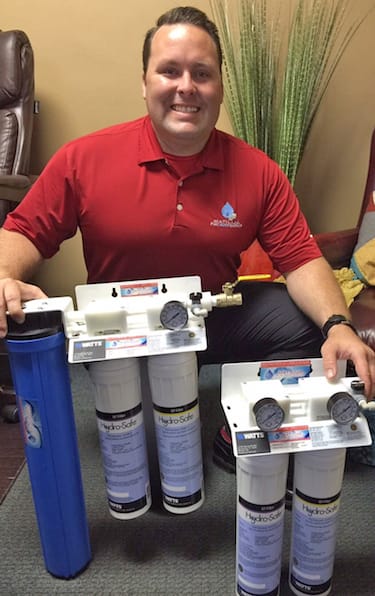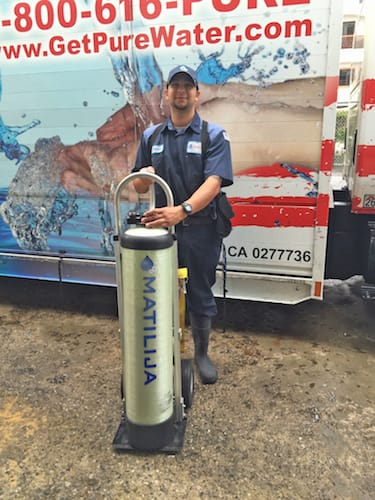Ontario, Calif. —The International Association of Plumbing and Mechanical Officials (IAPMO) is seeking applicants to serve as technical experts on Water Efficiency and Sanitation Standard (WE•Stand) task groups. The WE•Stand Technical Committee is seeking special subject experts to join the following task groups: 1. Alternate Water Sources — The scope of this task group is Read more
Uncategorized
Ontario, Calif. —The International Association of Plumbing and Mechanical Officials
(IAPMO) is seeking applicants to serve as technical experts on Water Efficiency and Sanitation Standard
(WE•Stand) task groups.
The WE•Stand Technical Committee is seeking special subject experts to join the following task groups:
1. Alternate Water Sources — The scope of this task group is to research technologies and develop
provisions for on-site treatment for storm water and blackwater catchment systems for non-potable
and potable reuse, and the appropriate disinfection and testing requirements for these systems
according to the end use. Additionally, definitions for different types of alternate water sources need
to be distinguished for better understanding across the industry.
2. Water Efficiency and Conservation — The scope of this task group is to investigate the waterefficiency
performance for the following:
• Different kinds of water heaters and water heating control strategies
• Pool covers that allow the collection of rainwater to be used as makeup water. The task group
will also research the efficiency performance of sand filters versus cartridge filters.
• Landscape plant material that reduces water usage. The task group will also review landscape
provisions in WE•Stand for updates.
• Using the performance path in RESNET HERS H20 and WER Index to compare with the
prescriptive path in WE•Stand.
3. Premise Water Supply System Design — The scope of this task group is to investigate premise
plumbing water supply system design provisions that would result in improved water quality and
water- and/or energy-efficiency performance. Strategies to investigate include minimizing pipe sizes
and lengths, strategically locating fixtures and appliances near each other and to the water heater,
piping strategies to prevent or minimize stagnation, velocity minimums and maximums for water
quality control, and technologies for leak detection devices.
4. Commercial Food Services — The scope of this task group is to research new water conservation
technologies for the commercial food service industry, including water treatment systems (POU
reverse osmosis, water softeners, etc.), dipper well alternatives, frozen carbonated beverage
machines, compressed air boosted pre-rinse spray valves, and biological and composting technologies
for FOG food waste management. The task group will explore better solutions for exempting the
requirement of tempering water for combination ovens, commercial food steamers, commercial
dishwashers, and ware washers while also considering the impact of hot water on grease interceptor
performance.
5. Non-traditional Toilets — The scope of this task group is to develop an informative appendix for
the Composting Toilet Inspection Checklist, and to investigate non-traditional toilets in the pending
ISO/FDIS 30500 Non-Sewered Sanitation Systems for possible inclusion in WE•Stand.
The objective of each task group is to develop recommendations for the WE•Stand Technical Committee for
consideration. Those interested in participating on the WE•Stand Task Groups may apply at
http://www.iapmo.org/WEStand/Pages/TechnicalCommittee.aspx.
A few months ago I started using the Milwaukee 8-gallon dust extractor. I’ve put it thru the ringer cleaning out old dirty oil boiler fire boxes, job site messes, used it around the shop and at home. This thing is a beast! Take a look at the video, I can say with honesty that as Read more
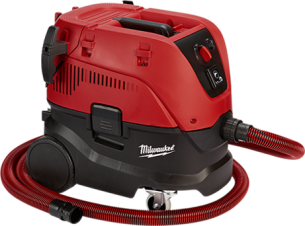
Milwaukee 8960-20
A few months ago I started using the Milwaukee 8-gallon dust extractor. I’ve put it thru the ringer cleaning out old dirty oil boiler fire boxes, job site messes, used it around the shop and at home. This thing is a beast!
Take a look at the video, I can say with honesty that as bad as that filter looks that thing just kept sucking.
There are a lot of well thought out features on this dust extractor, the first would be the low-profile design. Coupled with the perfect casters and large rear wheels the low center of gravity keeps it from tipping like other extractors I’ve owned or used. The longer than wide tub makes this deign possible. Its tool activation setting works without delay and keeps the vac running to clear the hose and filter once you’ve turned whatever you’ve got attached off. It also has a standard continuous run mode.
It comes with a 13 ft long anti-static hose and can be ran with or without fleece or plastic bags. From the start I have not used bags; I wanted to see how it performed and how long the filter life fared out without the bags. Using a bag will keep things cleaner overall though.
The extractor’s dual filtration system includes a HEPA filter, which captures 99.97% of all particles greater than 0.3 microns for best in class filtration and safety and provides users with an OSHA-compliant solution for the regulation on crystalline silica dust (29 cfr 1926.1153).
This is not a typical vac and its priced to reflect the technology built in to it. Do not make the mistake of comparing this to a typical ” shop vac “, the two are not the same nor are they designed for the same use and regulations.
https://www.instagram.com/p/BlWkKxAgQnq/?taken-by=mechanicalhub

Using a standard laser measure outside is often a hit or miss affair, dependent upon cloud cover, trees and a building roof or overhang that may block the sun. All of these random elements are now history thanks to the advanced technology and versatility of the Bosch BLAZE™ Outdoor GLM400C Connected Laser Measure with Viewfinder Read more
 Using a standard laser measure outside is often a hit or miss affair, dependent upon cloud cover, trees and a building roof or overhang that may block the sun. All of these random elements are now history thanks to the advanced technology and versatility of the Bosch BLAZE™ Outdoor GLM400C Connected Laser Measure with Viewfinder and the Bosch BLAZE™ Outdoor GLM400CL Connected Laser Measure with Camera.
Using a standard laser measure outside is often a hit or miss affair, dependent upon cloud cover, trees and a building roof or overhang that may block the sun. All of these random elements are now history thanks to the advanced technology and versatility of the Bosch BLAZE™ Outdoor GLM400C Connected Laser Measure with Viewfinder and the Bosch BLAZE™ Outdoor GLM400CL Connected Laser Measure with Camera.
Both outdoor laser measures rely on a 5.0-megapixel, 8X zoom camera with scratch-proof screen to find the laser target at up to 400 ft. in bright conditions, expansive indoor space or against busy backdrops. The easy-to-read color display illuminates large numbers and provides clear resolution in dark areas. The BLAZE GLM400CL version can take photos and comes with memory for 50 measurements and storage for up to 200 images, in addition to a lithium-ion battery.
Default real-time measurement provides immediate, accurate measuring that automatically adjusts as the user moves closer or father from the target. Measurement accuracy is +/- 1/16 in. Each device is sized to fit into any pocket for easy access. A digital bubble level provides a visual reference when measuring horizontal distances.
Measurement documentation can be transferred quickly to a smartphone or tablet relying on Bluetooth® connectivity in conjunction with Bosch’s MeasureOn app. Note: Photo files are too large to transfer via Bluetooth®, but can be transmitted using supplied USB cable. Easily organize, document and transfer measurements using the free Bosch MeasureOn app. The free-to-download app provides an intuitive and clear digital project overview, including floor plans, measurements and notes.
“Not every laser measuring job is indoors under controlled light conditions,” said Brandon Eble, product manager, measuring tools, Bosch Power Tools. “A high percentage of jobs will require some outdoor measuring. Typical jobs are in direct sunlight for about 75 percent of the project due to light coming through incomplete walls without drywall or another covering. This drove us to develop the Bosch BLAZE Outdoor GLM400C and GLM400CL laser measures. Our goal was to provide a tool that could be used for a full job, no matter the lighting conditions or distance required.”
The BLAZE Outdoor GLM400C and BLAZE Outdoor GLM400CL laser measures provide default real-time measuring, as well as length, area, volume and indirect measuring functions that are easy to employ using a display guide that walks the user through each measurement process. A built-in inclinometer determines the angle of pitch (tilt angle 360°), maximum/minimum stake out lengths and double indirect measurements. It also confirms when the tool is level.
The Bosch BLAZE Outdoor GLM400C with Viewfinder is powered by three AA batteries and includes a hand strap and pouch. The Bosch BLAZE Outdoor GLM400CL with Camera includes an integrated, rechargeable 3.1 Ah Lithium-ion battery that delivers enough runtime for all-day jobs, along with a micro USB cable, a battery charger, hand strap and pouch.
To learn more about the Bosch BLAZE Outdoor GLM 400 C Connected Laser Measure with Viewfinder Bosch BLAZE Outdoor GLM 400 C Connected Laser Measure with Camera or to find a local dealer, visit www.boschtools.com or call 877-BOSCH-99. Check out www.bethepro.com for additional tips and videos.
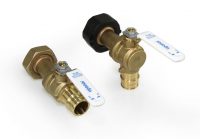
With PEX installations in new-home construction surpassing copper and CPVC combined, professionals need a reliable PEX product they can count on that will offer long-lasting performance and durability. Uponor is answering the demand with even more solutions for designers and installers to incorporate the value of a complete PEX plumbing system throughout a home or Read more
 With PEX installations in new-home construction surpassing copper and CPVC combined, professionals need a reliable PEX product they can count on that will offer long-lasting performance and durability.
With PEX installations in new-home construction surpassing copper and CPVC combined, professionals need a reliable PEX product they can count on that will offer long-lasting performance and durability.
Uponor is answering the demand with even more solutions for designers and installers to incorporate the value of a complete PEX plumbing system throughout a home or multifamily building.
With the ProPEX® water service offering, installers can connect directly to a water meter, eliminating the need for additional fittings and couplings, allowing professionals to provide the reliability, high-performance and efficiency of a complete Uponor AquaPEX® plumbing system from inlet to faucet.
Targeted for single-family homes and multifamily submetering, the offering is available in engineered polymer (EP) straight or angle fittings as well as lead-free (LF) brass straight or angle valves for connecting ¾” and 1″ Uponor AquaPEX® pipe to ⅝”, ¾” and 1″ water meters. Both fittings and valves feature NPSM swivel connections found on all water meters sized ⅝” to 1″.
The offering has tamper-resistant features to meet AWWA C708-2011, Section 4.3.11 requirements. The fittings and valves have holes that allow for wire to be inserted and soft-soldered to prevent dismantling.
The offering also includes mounting brackets to support the water meter system. The mounting brackets, which can be can be secured to the floor, wall or ceiling, hold the meter and piping in place while securing the system around the fittings or valves.
To learn more, visit uponorpro.com.

As the southwestern drought maintains its white knuckle grip on the central and lower parts of the Golden State, Californians continue to find resourceful ways to trim their water consumption. Businesses large and small are no exception. Seaside resorts—with massive pools, landscape to tend and mountains of laundry to wash—are among the largest water-consuming businesses Read more
As the southwestern drought maintains its white knuckle grip on the central and lower parts of the Golden State, Californians continue to find resourceful ways to trim their water consumption. Businesses large and small are no exception.
Seaside resorts—with massive pools, landscape to tend and mountains of laundry to wash—are among the largest water-consuming businesses aside from agriculture.
One famous resort in Santa Barbara is a 360-room ode to SoCal luxury. A guest reclined next to the pool, sipping a 93-point Pinot Noir, might find it easy to put all troublesome thoughts aside. But the resort’s outdated, wasteful water softening system wasn’t nearly as serene.

The 10 red, white and blue trucks in the Matilija fleet can be seen in and around Santa Barbara on a daily basis.
Environmental sustainability is something that resort management takes seriously, so late last year they began searching for solutions. With the help of nearby Matilija Pure Water Systems, they’ve recently made water- and salt-saving strides.
“The maintenance department contacted us early in 2015 about replacing the resin in their water softening system,” said Matt Raley, general manager at Matilija. “After visiting the facility, we developed a plan to save water, salt, and maintenance expenses.”
Time for an upgrade
Southern California’s water is hard, anywhere from 25 to 50 grains, and total dissolved solid levels range between 600 to 1,000 PPM. It’s this—along with a more recent emphasis on conservation—that has created high demand for water quality specialists in the Golden State.
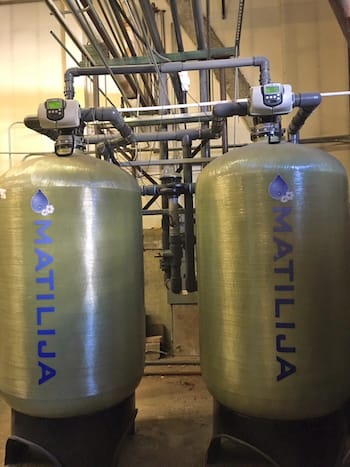
The two alternating, 30-cubic-foot mineral tanks now provide ample, continuous treated water at the resort.
And in Santa Barbara, Matilija Pure Water Systems leads the pack. The nearly-70-year-old firm provides uncompromising water quality service to the greater Santa Barbara area. All of their field staff either hold WQA (Water Quality Association) certification, or are working though the Professional Certification Program. And each technician carries a $500 well water test kit.
As the largest locally-owned water treatment company in the area, Matilija’s 10-truck crew focuses on residential and commercial water filtration, softening and purification. Their technicians maintain the systems they install, right down to scheduled salt deliveries.
The existing, 30-year-old water softening system at the resort included two, 60-cubic-foot mineral tanks. The steel vessels are so large that they were put in place before construction of the facility was compete. Raley wondered if it was worth the expense to replace the media.
After inspection, the answer was a resounding “no.” When the system was installed in 1986, it was generously sized to serve the entire resort. Not long after, plumbing changes across the 24-acre property removed half the load from the big system. Even so, the system wasn’t performing.
“The valves weren’t working correctly, so maintenance personnel were manually regenerating the media tanks,” said Matilija’s Service Manager, Daniel Masse. “And quite often, they had to do it twice, wasting a lot of water, time and salt. That’s a huge expense. We suggested they consider replacing the system instead of re-bedding it.”
Because of its huge volume, replacing the softener media would have been 25% of the cost to replace the entire system.
Fast-paced improvements
Within three weeks of the initial visit, Masse had designed a new system and the project went out to bid. In just a few short weeks, the resort would have a system that cut their salt use in half while actually delivering soft water.
“Ours wasn’t the lowest bid, but we also don’t cut any corners,” said Masse, who’s been with the company since 2010. “For example, I learned that one of the bids reduced the three-inch water lines down to two-inch valves. After we explained why we specified the larger valves, the resort saw the higher value in our proposal.”
In late June, with Masse leading the charge at the resort, a subcontractor was hired for extra manpower on the fast-paced project. With the laundry and main water heaters depending on the water supply, resort management wanted the task completed in a matter days.
“We installed a metered Watts WS3 valve and two alternating, 30-cubic-foot mineral tanks,” continued Raley. “We’re the largest Watts dealer in this area. Over the past 10 or 15 years using the product, we’ve found the support we receive to be outstanding. It’s also a big benefit to work with a manufacturer that makes a component for just about every application we encounter.”
Despite being half the size of the original mineral tanks, it was no walk in the park getting the new units in place. There was no room to install the new system next to the old one, so water lines needed to be piped into the adjacent boiler room. The new tanks were lowered over a handrail and eight feet down into the mechanical space.
A large, three-way bypass valve was installed right away, and new schedule 80 PVC was suspended from ceiling anchors.
“Before the retrofit, the resort was manually-regenerating their tanks, using two pallets of salt each month, and still didn’t have soft water,” said Masse. Now, they’re using half as much salt, water tests indicated zero grains of hardness, and the system regenerates automatically.”
The entire eight-day project was a race against the clock. Hiring the extra help played a key role in the success of the project, and so did familiarity with the products used.
“When we find good products, we stick with them,” said Raley. “We’re not the cheapest source of water quality expertise, but we provide premium service and carry high-end components. We shy away from less expensive water treatment products because we’ve learned they just doesn’t hold up in SoCal.”
Matilija Pure Water Systems’ dedication to superior product and service is apparent. If one look at an installation isn’t convincing enough, the fact that they have between 3,000 and 5,000 reoccurring customers tells the rest of the story. It comes as no surprise that a resort that’s known for an uncompromising guest experience would hire water quality experts with the same reputation.
“Given the option to marginally improve the old water softening system or make great strides to conserve salt and water, the resort management chose to make a real investment in the future,” said Raley. “That says a lot about their commitment to providing the best possible atmosphere for guests, as well as their standpoint on environmental sustainability.”

